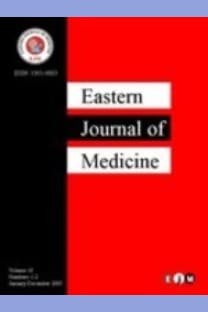Anesthesia Management in Laparoscopic Sleeve Gastrectomy Cases
___
1. WHO | Obesity and overweight. WHO 2016.2. Turkey Endocrinology and Metabolism Society of Obesity Diagnosis and Treatment Guide. Obesity, Dyslipidemia, Hypertension Working Group 2014; 1: 11- 5
3. Lukosiute A, Karmali A, Cousins JM. Anaesthetic Preparation of Obese Patients: Current Status on Optimal Work-up. Curr Obes Rep 2017; 6: 229- 237.
4. Akbas S, Ozkan AS. Comparison of effects of low-flow and normal-flow anesthesia on cerebral oxygenation and bispectral index in morbidly obese patients undergoing laparoscopic sleeve gastrectomy: a prospective, randomized clinical trial. Videosurgery Miniinv 2019; 14: 19-26.
5. Shimonov M, Schechter P, Boaz M, Waintrob R, Ezri T. Does Body Mass Index Reduction by Bariatric Surgery Affect Laryngoscopy Difficulty During Subsequent Anesthesia?Obes Surg 2016; 26: 2640-2647.
6. Cormack RS, Lehane J. Difficult tracheal intubation in obstetrics. Anaesthesia 1984; 39: 1105-1111.
7. Shiga T, Wajima Z, Inoue T, et al. Predicting difficult intubation in apparently normal patients. Anesthesiology 2005; 103: 429-437.
8. Juvin P, Lavaut E, Dupont H, et al. Difficult tracheal intubation is more common in obese than in lean patients. Anesth Analg 2003; 97: 595-600.
9. Brodsky JB, Lemmens HJM, Brock-Utne JG, et al. Morbid obesity and tracheal intubation. Anesth Analg 2002; 94: 732- 736.
10. Elay G, Bahar I, Oksuz H. Youn bakımda hava yolu yönetimi. In: Nimet Senoglu (edt). Olgularala Yogun Bakım Protokolleri (1st ed). Ankara: Nobel Tıp Kitabevleri 2019; 45-57.
11. Lundstrøm LH, Møller AM, Rosenstock C, et al. High body mass index is a weak predictor for difficult and failed tracheal intubation. Anesthesiology 2009; 110: 266-274.
12. Dohrn N, Sommer T, Bisgaard J, Rønholm E, Larsen FJ. Difficult Tracheal Intubation in Obese Gastric Bypass patients. Obes Surg 2016; 26: 2640-2647.
13. Johnson BL, Blackhurst DW, Latham BB, et al. Bariatric surgery is associated with a reduction in major macrovascular and microvascular complications in moderately to severely obese patients with type 2 diabetes mellitus. J Am Coll Surg. 2013; 216: 545-556.
14. Yska JP, van Roon EN, de Boer A, et al. Remission of type 2 diabetes mellitus in patients after different types of bariatric surgery: a population-based cohort study in the United Kingdom. JAMA Surg. 2015; 150: 1-8.
15. Rao KVN, Dhatchinamoorthi D, Nandhakumar A, et al. Validity of thyromental height test asa predictor of difficult laryngoscopy:A prospective evaluation comparing modified Mallampati score, interincisor gap, thyromental distance, neck circumference,and neck extension.Indian J Anaesth 2018; 62: 603-608.
- ISSN: 1301-0883
- Yayın Aralığı: 4
- Başlangıç: 1996
- Yayıncı: ERBİL KARAMAN
Pediatric Sweet Syndrome: A rare Cause of Fever of Unknown Origin
ÖZLEM ÖZGÜR GÜNDEŞLİOĞLU, Necdet KUYUCU, Ferah Tuncel DALOGLU, İCLAL GÜRSES
Prick Test Results and Total IgE Levels of Asthma Patients in A University Hospital
Barış ÇİL, Mehmet KABAK, İCLAL HOCANLI, Ayşe Füsun TOPÇU, MAHŞUK TAYLAN
Mesut OZGOKCE, Nuri HAVAN, Ferhat CUCE, Fatma DURMAZ, Zakir SAKCI
Anesthesia Management in Laparoscopic Sleeve Gastrectomy Cases
ARZU ESEN TEKELİ, Esra EKER, Mehmet Kadir BARTIN, Muzaffer Önder ÖNER
Ramazan DERTLİ, Yusuf KAYAR, Neslihan SÜRMELİ, Mehmet Ali BİLGİLİ, Ahmet KARAKARCAYILDIZ, Nur DÜZEN OFLAS, Nurettin KURT
Ahmet ÇELİK, MUHAMMED İKBAL ŞAŞMAZ
Elif ÜMİT, Hasan ÜMİT, Hasan GÖZE, Mehmet BAYSAL, Ahmet Muzaffer DEMİR
Is Hyaluran A Biomarker In Patients Without SepsisRelated Liver Injury?
İlhan BAHAR, GÜLSEREN ELAY, ADNAN BAYRAM
Ruptured Pulmonary Hydatid Cysts in The Course of Enteric Fever; An Unreported Case
Hanifi YILDIZ, SELAMİ EKİN, AHMET ARISOY, Hatice BEYAZAL POLAT, Fatma BEYAZAL ÇELİKER
Comparison of Cleft Lift and Limberg Flap Techniques For Pilonidal Sinus Surgery
ORHAN AĞCAOĞLU, Ahmet Cem DURAL, Candaş ERÇETİN, TUGAN TEZCANER, Mahir KIRNAP, TURGUT ANUK
